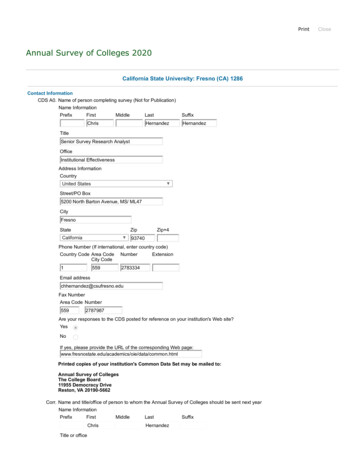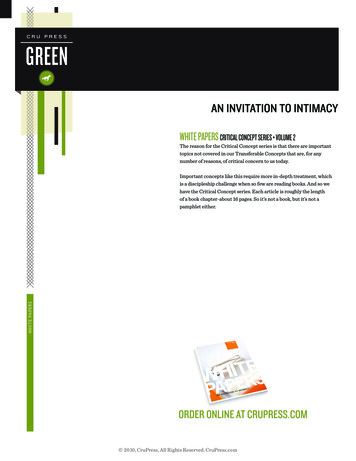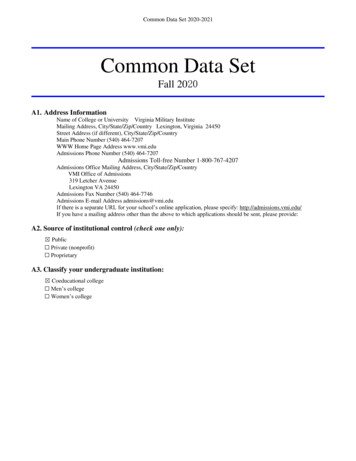
Transcription
Annals of Journalism and Mass CommunicationVolume 1, Issue 1, 2019, PP 24-31Degrees of Intimacy in Modern Civilization:An Investigation ofFulton Sheen’s Thesis on Radio, Television and PersonalAppearanceJustine John DyikukUniversity of Jos Nigeria, Mass Communication, Faculty Member, Nigeria.*Corresponding Author: Justine John Dyikuk, University of Jos Nigeria, Mass Communication,Faculty Member, Nigeria.ABSTRACTIn whichever form of relationship, intimacy reveals communication and communion. When thiscommunication is between a human being and an inanimate object, it sparks off less communion and morecommunication. When it concerns human persons in interpersonal relationship, it elicits both communicationand communion. With this motivation in mind, the researcher embarked on a review-paper titled: “Degreesof Intimacy in Modern Civilization: An Investigation of Fulton Sheen Thesis on Radio, Television andPersonal Appearance.” Results of the qualitative study revealed that the author’s views that radio, televisionand personal appearance are metaphors for degrees of intimacy namely, hearing, seeing and touching areapt. However, in the context of pastoral communication, the author did not highlight the contents of bothradio and television and how they apply to communication. The study recommended further profoundappreciation of Sheen’s thesis and research about his involvement with the media. It concluded that ifharnessed, the degrees of intimacy in modern civilization would foster greater communication between Godand man and between human beings and the created order with all the advances in technology there are.Keywords: Civilization, Fulton, Radio, Sheen, TelevisionINTRODUCTIONCommunication is at the heart of everyinteraction (Nardelli, 2013). Be it intrapersonalor interpersonal communication, the levels ofcommunication is characterized by some degreeof interface. This is why the interaction thattakes place between a human being and aninanimate object is described as extracommunication (Free BCom Notes, 2015). Thiskind of communication does not onlyunderscore the various levels of communicationthere are but speaks to the heart of verbal ornonverbal communication. This is whycommunication experts do not take any kind ofcommunication for granted (Bannister, 2018;Erdogan & Bauer, 2010). The current highpremium placed on the various means ofmodern communication which characterisemodern civilization tells the story more.thIndeed, from the end of the 20 to the early partof the 21st century, there have been explosionsinInformationandCommunicationsTechnology (ICT) leading to proliferation ofmedia platforms. The avalanche of MediaCorporations have further brought about moresocial engagements and media convergence thusexpanding the frontiers of sociability, education,trade, commerce and investments. To beprecise, social media is now revolutionalizinghow companies communicate (Buyolo, 2018). Itis interesting to look with hindsight how themedia fared in yester years. This is whereFulton Sheen‟s thesis on the degrees of intimacyin modern civilization namely, radio, televisionand personal appearance come in as a hugeresource for critical review in the light ofmodernmediatrendsandpastoralcommunication.Given the rise in media development andcontent (Kaul, 2012), the thoughts of yesterdaysuch as Sheen‟s are crucial for media activitiesin the world today. Therefore, this study aimsat: Doing a critical review of Fulton Sheen‟stimeless thesis on the degrees of intimacy inmodern civilization; Investigation the pros and cons of hissubmission on radio, television and personalappearance;Annals of Journalism and Mass Communication V1 I1 201924
Degrees of Intimacy in Modern Civilization: An Investigation of Fulton Sheen’s Thesis on Radio,Television and Personal Appearance Highlighting grew areas of modern media thatfits Sheen‟s narrative; Putting forward other views in addition to thedegrees of intimacy; Proposing further research into Sheen‟sinvolvement with the media.This qualitative study employs the historicalnarrative which enables the researcher to rely onexisting literature, particularly Fulton Sheen‟sworks and commentaries for analyses, critiqueand recommendations.CLARIFICATIONSModern CivilizationModern civilization stands for the end of the20th and the earliest part of the 21st centurieswhich ushered in explosions in radio andtelevision productions as well as variousinterpersonal relationships and communicationotherwise known as personal appearance.Degrees of IntimacyIn this study, based on the explanation of FultonSheen, we would understand the degrees ofintimacy in modern civilization as radio,television and personal appearance anddemonstrate how they analogously relate to thetrio of hearing, seeing and touching. Degrees ofintimacy shall also be used to explore elementsof pastoral communication such as hearingwhich represents the Old Testament and visionand touch which stands for New Testamentperspectives of communication.LITERATURE REVIEW AND DISCUSSIONFulton Sheen: A Brief BiographyFulton John Sheen also known as Bishop orVenerable Fulton J. Sheen was born on May 8,1895 in El Paso, Illinois, United States ofAmerica. He attended St. Viator College, inBourbonnais, Illinois, where he bagged B.A. in1917 and M.A. in 1919 respectively. Manyyears later, he was ordained a Catholic priest. In1920, he had a bachelor‟s degree in Canon Lawfrom the Catholic University of America inWashington, D.C (Stefon, 2019).He crowned his studies with a Ph.D. inPhilosophy from the Catholic University ofLeuven, Belgium in 1923 and a Doctor ofSacred Theology from the Pontifical Universityof St. Thomas Aquinas, Rome in 1924 in thatorder. Upon his graduation, he worked inLondon as a priest for a year after which he left25for Peoria, Illinois, in 1926 where he served as aparish priest. From that time to 1950, Sheenworked as a professor in the faculty ofphilosophy, Catholic University of America(Stefon, 2019).Between 1958 and 1966, Sheenwas the National Director of the Society for thePropagation of the Faith until his appointmentas bishop of Rochester, New York. By 1969, hebecame the Archbishop of Newport, Wales. Hisfame reached the Vatican where he served PopePaul VI as Assistant to the Pontifical Throne, aposition he occupied for three years until hisdemise. Sheen died in New York on December9, 1979 at the age of 84 due to heart problems.He was described by Pope Pius XII as “aprophet of the times” (TheFamousPeople.com,2017). In 2012, he was made a venerable byBenedict XVI having lived a virtuous life. In theCatholic Church, this is a major requirement forcanonization as a Saint. The prolific writer hasmore than 73books to his credit(TheFamousPeople.com, 2017) among whichare, Communism and the Conscience of theWest (1948), Way to Inner Peace (1955), andThe Power of Love (1965) to mention just a few(Stefon, 2019).Sheen’s Involvement with the Media: AnOverviewSheen was no novice to the media. He is widelyrecognised as one of the first televangelists inthe Catholic Church (TheFamousPeople.com,2017). This is because, from 1961 to 1969, hehad a popular television programme titled, TheBishop Fulton Sheen Show. This he combinedwith writing of ingenious books and being asyndicated newspaper columnist. Oftendescribed as an American religious leader(Catholic priest), writer, televangelist, and radiopresenter, Sheen displayed great teaching andoratory skills. He was such a humble man. Oncehe was asked about his successes and he said,“The Lord once used an ass to ride intoJerusalem. Now he uses an ass on TV” (Ku,1994). It is interesting to note that Sheen‟s TVprogrammes were “more ecumenical anddirected to Catholics, Protestants, Jews and allmen of good will” (Ku, 1994).This paved way for his involvement with themedia and his rising popularity in radio in theearly part of the 20th century. His talks attractedwide audiences. It would be recalled that in1930, the 22-year radio career on the programThe Catholic Hour, which he began had anestimated audience of four million listeners.Annals of Journalism and Mass Communication V1 I1 2019
Degrees of Intimacy in Modern Civilization: An Investigation of Fulton Sheen’s Thesis on Radio,Television and Personal AppearanceThis could be described as the height of hismedia career and popularity (Stefon, 2019).Even when he was made a titular bishop andserved as auxiliary bishop of New Yorkbetween 1951 and 1966), he had time to host aweekly television series titled, Life Is WorthLiving. It is on record that the programmeattracted about 30 million viewers. “On thatshow the bishop, often speaking without a scriptand appearing at his characteristic chalkboard,discussed practical matters of faith and sharplycriticized communism” (Stefon, 2019).In 1952, Sheen received the Emmy Award forthe category of “Most Outstanding TelevisionPersonality” beating Lucille Ball, JimmyDurante and Edward R. Murrow (Lynch, 1998).Accordingly, “After winning, he was featuredon the covers of Time, TV Guide, Colliers, andLook” (Reeves, 2000). Reflecting on thelegacies and the lessons of Fulton Sheen,Bishop Barron maintained that “VenerableSheen is remembered as one of the greatestCatholic evangelists of the twentieth century. Amaster of both television and radio, [who] shared the Gospel with millions using hisunique blend of wit, humor, and insight”(Wordonfireshow.com, 2016).The Encyclopedia of World Biographyportrayed him as “one of the unlikeliestsuccessful television personalities of the“Golden Age” in the 1950s” who was one of themost visible members of the Catholic Church“and an excellent ambassador for the church tothe secular world” (Encyclopedia.com, 2019).About Sheen, Director Edward Stasheffremarked: “His whole technique was themagnetic effect of the way he looked into thecamera. I hate to use a cliché, but the word is„telegenic.‟ He was made for the medium”(Encyclopedia.com, 2019).His speeches were recorded on reel-to-reel tape.This led to the establishment of “Ministr-OMedia” and the release of his speech on audiotape titled, “Renewal and Reconciliation.” Thatis not all, within a short time, the “Ministr-OMedia” rose to becoming one of the biggestdistributers of non-music tapes which generateda lot of income. While his autobiography titled,“Treasure in Clay: The Autobiography of FultonJ. Sheen” was posthumously published in 1980,other materials like his papers and TVprogrammes are kept at St. Bernard's School ofTheology and Ministry in Rochester, New .com, 2017). To be sure, “hewas the most popular public speaker in theChurch, and arguably the best” (Reeves, 2000).RADIO, TELEVISION AND PERSONALAPPEARANCE AS METAPHORS FORDEGREES OF INTIMACYIn this book Life is Worth Living, Fulton Sheenproposes three degrees of intimacy which heargues are known to every human heart. Hecontends that these degrees of intimacy whichare known to the human heart are either distantlike echo or close enough to vibrate the humanheart. As if moving from the known to theunknown, Sheen guides the reader throughhuman contact to the degrees of intimacy inhuman civilization namely, radio, television andpersonal appearance. He maintains that each ofthese is friendly than the one which precedes it(Sheen, 2013,p.183). What is interesting in whatthe researcher prefers to refer to as his medianarration is his ability to ensure smoothtransitionfromelementsofhumancommunication to crucial aspects of extracommunication. We shall highlight is take onradio, television and personal appearance thus:RadioSheen submits that through the harnessing oflight and sound, radio is the first degree ofintimacy. He emphasised that sound does nottravel very fast because in a certain temperature,its speed is about 1,200 feet per second. On thecontrary, light travels about 186,000 miles asecond.He goes ahead to argue that when sound isamplified and dispatched with great speed oflight, “one is able to talk in a few seconds tomore people than Saint Paul addressed in all ofhis missionary journeys” (Sheen, 2013,p.183).This conclusion is appropriate because it revealsthe impact of technological advancement onhuman endeavour.It is interesting that as far back as that time,Sheen was able to allude to the fact that radio asa medium of communication has the widestoutreach. This is a truism attested to by bothscholars and media experts (Mathur, 1990 &Diamundialradio.org, 2019).Another interesting part of his commentary onradio which is laced with analogies is hisposition that there is delayed feedback as far asradio is concerned because “the listener isunable to return the speech, nor is he ever ableAnnals of Journalism and Mass Communication V1 I1 201926
Degrees of Intimacy in Modern Civilization: An Investigation of Fulton Sheen’s Thesis on Radio,Television and Personal Appearanceto talk back” (Sheen, 2013,p.183). Despite thischallenge, Sheen makes the point that listenerswho are unable to return a speech arecompensated by what he describes as “theamazing power in the human wrist, which canshut off any programme it dislikes” (Sheen,2013,p.183).An important point to note in this submission isthat the author under review touched on “Usesand gratification” – a media theory whichdemonstrates the power of the listener or viewerto change a channel or station of his or herchoice if a programme does not satisfy his orher desire (David, 2016).Finally, he recommends that those behind theradio ought to be discreet and subdued because:“when one sees the smile on the face, oneknows that certain words are not to be taken tooseriously. When the eye does not see, the ear isapt to be more sensible and critical” (Sheen,2013,p.183).TelevisionOn television as a medium of communication,the scholar maintains that because it adds thedimension of seeing to that of hearing, TVsatisfies one of the desires of the human naturefor increased intimacy.Using the analogy of a soldier in a camp whoupon boasting about the beauty of the one heloves to his colleagues is left with the challengeof showing them her live picture, Sheendiscloses that: “Television enables the audienceto test the sincerity of the speaker by the mannerin which he delivers his message” (Sheen,2013,pp.183-184). He, however, notes that it isimportant to make due allowance for thosebehind the camera because the televisionaudience do not often realise that the speakerhas multiple distractions such as camera, light,sound booms, engineers, technicians, directorsand stagehands to contend with.Commentating on the downside of television,the televangelist noted that using televisioncomes with the test of sincerity. This is becauseit is difficult for the audience at home to knowwhether the speaker is sincere or not.Whether he uses the teleprompter or he readsfrom cards, ascertaining the sincerity of thosebehind TV programmes is difficult. He,however, stated that one way the viewingaudience at home can tell if the presenter isusing a teleprompter is to check if his eyes aremoving from left to right and if he is reading27from a card, they should check if his eyes aremoving up and down (Sheen, 2013,p.184).Personal AppearanceFrom man‟s use of radio and television whichdiscloses extra-communication, Sheen catapultsthe discourse to interpersonal communicationwhich he describes as “the most intimate formof audience relationship [where] there is notonly a positive communion of personality withpersonality but also an exchange of ideas whichis the mark distinguishing man from beast”(Sheen, 2013,p.184).He insists that personal appearance, that is,meeting a person and establishing communionwith him surpasses hearing his voice on radio aswell as seeing his other image on the screen.What is clear in this position is theindispensableplaceofinterpersonalcommunication despite advances in technology.What is paramount here is the interface ation.THREE DEGREES OFMODERN CIVILIZATIONINTIMACYINIt is instructive to note that Fulton Sheen furtherdiscloses that radio, television and personalappearance correspond to another triointimacies, that is, hearing, seeing and touching:HearingIn an unprecedented exposé, the cerebral TVpresenter stated that the first intimacy of thesenses that corresponds to the radio is theintimacy of hearing.To buttress the value of hearing, he emphasisedthat we may never know that someone loves usunless he told us. He argued that: “Speech is thesummation of a soul: all that it has been, all thatit is, and all that it will ever be” (Sheen,2013,p.185). Giving concrete examples, Sheencontends that it is only when we hear someonespeak that we can say he is learned, kind, cruelor humble. Noting that “the first language oflove - is that of speech in one and hearing inanother,” (Sheen, 2013,p.185) he insists thatcharacter is revealed in great books of the pastlike those of Sophocles, Aristotle, Aquinas,Bonaventure, Bossuet to mention a few.SeeingFrom hearing, he moves to the sense of seeing.On the intimacy of love which he calls vision,Sheen states that, “the heart is never satisfiedAnnals of Journalism and Mass Communication V1 I1 2019
Degrees of Intimacy in Modern Civilization: An Investigation of Fulton Sheen’s Thesis on Radio,Television and Personal Appearancemerely at hearing the words of the beloved or atreading his message.It wants to see the words born on human lips,see the earnestness of a visage, the flash of aneye, and the sincerity of character in theexpression of the face” (Sheen, 2013,p.185).Highlighting the import of images on the mind,the TV presenter surmised that: “Communionbetween persons begins to be intense andvibrating the moment the image of the other isimpressed on the mind and carved into theheart” (Sheen, 2013,pp.185-186).TouchingOn the intimacy of touch, the author underconsideration disclosed that it is an intimacythat is so deep, profound and personal. He statesthat “in the order of senses, touch is the highpoint of contact of personality with personality”(Sheen, 2013,p.186). He views the intimacy oftouch as a privilege which is why people oftenseek permission before they touch others. Hecites examples as a mother touching her child, anurse, her sick patient, a husband welcoming hiswife and a wife her husband to describe touch as“the crown of affection and the high point offellow feeling of heart and heart” N IN SHEEN’S NARRATIVEA striking dimension of Fulton Sheen‟s thesis ishis linking of the intimacies of love and theiranalogies in radio, television and personalappearance with God‟s dealing with humanity.This is interesting because it brings to the forethe all-important elements of pastoralcommunication.We shall now underscore God‟s contact withhumanity and the communicative relationshipwhich flows from it based on Sheen‟sassumptions that radio is Old Testament andtelevision and personal appearance as Jesusrevealed in the New Testament:Old TestamentIn his seminal submission, the scholar brings inthe aspect of pastoral communication byreferring to radio as Old Testament. He notesthat “God has spoken! To find His speech weneed to turn over the pages of the OldTestament; there is written the speech of God.The Old Testament is something like radio: aspeech without vision” (Sheen, 2013,p.186). Hegoes ahead to give instances like the giving ofthe Ten Commandments (Exodus 20:1-17)which have since became the fabric of theworld‟s civilization.This implies that the Old Testament like theradio was about God‟s speech and invariably thespeeches of the prophets and sages about theexpected messiah that would come in Davidicform.While the prophets from Moses throughMalachi made noise about the future leader ofIsrael, what transpired in the old dispensationwas basically voice without a correspondingvision of the actual person being expected. Thisleads us to vision.New TestamentSheen likens the New Testament to television.He argues that love wants to see that is why it isnot satisfied with hearing the speeches of abeloved alone. He makes the point that “If Godis to sound another intimacy of love, He mustnot only speak to men; He must be seen. Visionmust be added to revelation.This was done at the incarnation of the Son ofGod in the Person of Jesus Christ. God was seen- seen in the form of a Babe in fulfilment of aprophecy seven hundred years old that His namewould be called Emmanuel: „God with us.‟ Mensaw Him in a thousand other ways” (Sheen,2013,pp.187-188). In the New Testament times,Christ was seen, he was engaged with thechildren and stressed the need for humility.Jesus as Perfect tion is the assertion found in thePastoral Instruction on the Means of SocialCommunication which states that through hisincarnation, while he was on earth, Christrevealed Himself as the Perfect Communicatorwho totally identified himself with those whoare expected to receive his communication, bygiving his message in words and by the mannerof his life and preaching the divine message outof the press of his people without fear or favourthus adjusting to his people‟s way of life(Communio et Progressio, 1971, no.11). Thepoint is, although God‟s voice was heard and hisperson was made visible in Christ, he needed toexplore another form of intimacy namely touch.That was displayed when the woman with theissue of blood touched him (Cf. Matthew 9:20–22; Mark 5:25–34 & Luke 8:43–48) and whenMary of Magdala poured oil on his feet andwiped away the tears with her hair (Cf. LukeAnnals of Journalism and Mass Communication V1 I1 201928
Degrees of Intimacy in Modern Civilization: An Investigation of Fulton Sheen’s Thesis on Radio,Television and Personal Appearance7:36-50). He submits that: “The greatest of alltouches was given by a man who doubted HisDivinity” (Sheen, 2013,p.188). This led toThomas‟ solemn profession of faith, “My Lordand My God” (John 20:28).EYE OF FAITH AS “INTERNET”The drama that ensued between Jesus andThomas leads us to another dimension ofintimacy beyond vision that is, the eye of faithwhich is the response of the heart that is morereliable and close than that which the eyes seeand fingers feel (Sheen, 2013,p.188). TheScriptures insist that faith is unlimited; that itcan move mountains and do all things (Matthew17:20). Although Fulton Sheen did not factor ininternet in his thesis, the researcher is of theopinion that the “eye of faith” can be likened tothe internet because has limitless possibilities.With various platforms such as blogs, podcastsand other networking sites, the internet dailyoffers limitless possibilities for socialinteraction, business and commerce, researchand education, democracy and governance,culture and entertainment to mention just a few,to great number of audiences. Because it existsin virtual space, the internet allows a person toengage others even without seeing them. Whilethis has advantages, it also has its down sides.This is why all internet users ought to exercisecaution in using the modern means ofcommunication.Notwithstanding these challenges, in all hermedia-related documents, the Church hasalways maintained that the mission ofproclaiming the Gospel of the Christ to the endsof the earth until the second coming of the Sonof Man requires using the media (Paul VI, InterMirifica no.3; Paul VI, Evangelii Nuntiandi,no.45; John Paul II, Redemptoris Missio, no.37;Pontifical Council for Social Communications,Communio et Progressio, nos.126-134 &Aetatis Novae, no.11) of which internet is itsnewest and finest expression.CRITIQUE AND CONCLUSIONCritiqueWhile Sheen‟s analogy of radio is apt, hefocused mainly on the technicality of light andsound as well as lack of instant feedbackbetween a speaker and the audience. His viewsthat the listener is at liberty to switch or changechannel and that the speaker should be discreetare crucial. However, while he was29overwhelmed by the amazing power of radioand how the audience can assess the speaker, hedid not say anything about the content of radio.One would have expected an insight on radiocontent given his practical application of thesedegrees of intimacy to communication.His views on television, especially the amazingpower of combining sight and sound, are vital.It is true that television enables the audience totest the sincerity of the speaker. His disclosurethat sometimes the audience may not be awareof the distractions the speaker faces is timely.Nevertheless, while he was carried away withtechnicalities, Sheen did not give insights aboutprogramming and timing. Although he waswriting for a western audience, the authorshould have taken Africa into cognisance wheredeficit in power affects access to television.The author‟s praise of personal appearance asthe sumum bonum is commendable. By statingthe important role of the interface ation, he leaves us with theimpression that like science, communication isdynamic and ever expanding. Despite hisseeming plausible articulation of personalappearance as the finest expression ofcommunication, Sheen did not provide us withthe requisite ethics of that kind of tion, there are tendencies of hurtingothers or breaking a promise. This could affectpersonal appearance as a way of communicatingoneself to another.While his views about hearing, seeing andtouching are appropriate, he could not reallyblend New Testament and the Person of Jesus inthe analogy of touch. One would have expectedhim to clarify “touch” as explaining theincarnation in the New Testament. Apparently,the present presentation of ideas by the authorcould be misleading as the uninitiated might beconfused when they read his explanation ofincarnation. This is why this researcher stretchesthe point on the “eye of faith” as an analogy forthe internet.By way of recommendation, the study advocatesa profound appreciation of Sheen‟s thesis. Theresearcher acknowledges that this review-paperis not exhaustive about the subject matter. Thisis why it is necessary that further empiricalresearch is carried out about Fulton Sheen‟sinvolvement with the media. In furtherance ofeducational advances especially in mediaAnnals of Journalism and Mass Communication V1 I1 2019
Degrees of Intimacy in Modern Civilization: An Investigation of Fulton Sheen’s Thesis on Radio,Television and Personal Appearancestudies, paying close attention to the extantmedia-works of the author remains beneficial toboth researchers and students of media.ConclusionFrom the foregoing, the author underconsideration gradually guides readers from asecular discourse to one which ends with adivine reality. He captured this beautifully whenhe noted: “There is nothing more that God cando to exhaust the intimacies of love. He hasspoken; he has been seen; and He has beentouched. To each and every person in the worldHe has given at least one of these intimacies. Heis heard in His scripture and by the invisible earof the soul attentive to the whispering of HisChurch, which is growing in age and grace andwisdom through centuries” (Sheen, 2013,p.189).Apparently, Sheen drives his audience from asecular press to a divine press in communicativeeldorado. Perhaps it is why this is was said ofhim: “He was truly a pioneer in Catholic media,and as Pope Francis urges us to venture out intothe peripheries, and as Saint Pope John Paul IIencouraged us to find new means to do so, weneed only look to Fulton Sheen as the example”(The young Catholic woman.com, 2017).We have seen how important it is to blend extracommunicationwithinterpersonalcommunication. This is because, “The finalintimacy of all is that touch reserved only forthe chosen few who enjoy a communion withHim that is almost an interpretation of theDivine and the Human, an embrace of lovewhen He who is the Divine Host comes into thehuman heart as its Guest. It does not requiremuch time to make us saints. It requires onlymuch love” (Sheen, 2013,p.189). From theinvestigation of Fulton Sheen‟s thesis on radio,television and personal appearance so far, it issafe to conclude that if the degrees of intimacyin modern civilization are further harnessed, thepastoral dimension of community would fostergreater communication between God and manand between human beings and the createdorder with all the technologies there are.[3][4][5][6][7][8][9][10][11][12]REFERENCES[1] Bannister, J (2018). Importance of the cessed3/15/19.[2] Buyolo, M (2018).Social Media tionised-the-way-companiescommunicate-31ca91b4fa3. Accessed 3/15/19.Catholic Church, (1976). Apostolic exhortation:Evangelii nuntiandi of His Holiness Pope PaulVI to the episcopate, to the clergy and to all thefaithful of the entire world on evangelization inthe modern world. London: Catholic TruthSociety.Catholic Church, (1990). Encyclical letterRedemptoris missio of the supreme pontiff JohnPaul II on the permanent validity of the church'smissionary mandate. Washington, D.C.: UnitedStates Catholic Conference.Catholic Church. (1992) Aetatis novae: Pastoralinstruction on social communications on thetwentieth anniversary of Communio etprogressio. Pontifical Commission for SocialCommunications. Washington, D. C:UnitedStates Catholic Conference.David, L (2016) “Uses and gratification om/uses-and-gratification-theory.html.Accessed 3/18/2019.Diamundialradio.org, (2019).World radio day2019 contest. www.diamundialradio.org/home.Accessed 3/18/2019.Editors, TheFamousPeople.com (2017). files/fultonjohn-sheen-1440.php. Accessed pedia, 6
Fulton John Sheen also known as Bishop or Venerable Fulton J. Sheen was born on May 8, 1895 in El Paso, Illinois, United States of America. He attended St. Viator College, in Bourbonnais, Illinois, where he bagged B.A. in 1917 and M.A. in 1919 respectively. Many years later, he was ordained a Catholic priest.











